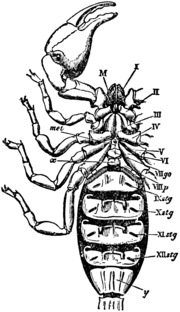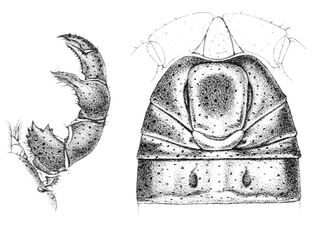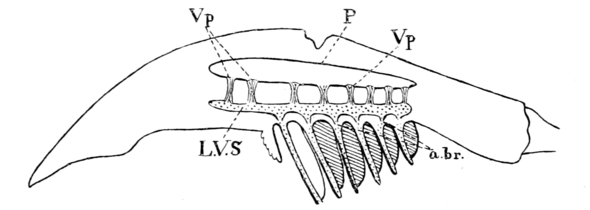「書鰓と書肺」の版間の差分
編集の要約なし |
編集の要約なし |
||
| 7行目: | 7行目: | ||
名に表れるように、書鰓と書肺はそれぞれ[[鰓]]と[[肺]]のように機能する[[呼吸器]]で、[[書物]]のように畳んだ複数の平たい構造体でできている。この構造体はラメラ(lamella、薄葉・薄板とも)といい、その数は分類群によって十数枚から百枚以上に及ぶ。ラメラの間には隙間が空いており、ここで表面が[[水]]ないし[[空気]]に接触して[[呼吸]]が行われる<ref>{{Cite journal|last=Fincke|author=|first=Till|last2=Paul|first2=Rüdiger|year=|date=1989|title=Book lung function in arachnids: III. The function and control of the spiracles|url=http://link.springer.com/10.1007/BF00692415|journal=Journal of Comparative Physiology B|volume=159|issue=4|page=|pages=433–441|language=en|doi=10.1007/BF00692415|issn=0174-1578}}</ref>。書肺の場合、空気を出入させる隙間を維持するように、たくさんの小柱(trabecula)がそれぞれのラメラの表面に配置される<ref>{{Cite journal|last=Kamenz|author=|first=Carsten|last2=Dunlop|first2=Jason A|last3=Scholtz|first3=Gerhard|last4=Kerp|first4=Hans|last5=Hass|first5=Hagen|year=|date=2008-04-23|title=Microanatomy of Early Devonian book lungs|url=https://www.researchgate.net/publication/5653652_Microanatomy_of_Early_Devonian_book_lungs|journal=Biology Letters|volume=4|issue=2|page=|pages=212–215|language=en|doi=10.1098/rsbl.2007.0597|issn=1744-9561|pmid=18198139|pmc=PMC2429929}}</ref>。 |
名に表れるように、書鰓と書肺はそれぞれ[[鰓]]と[[肺]]のように機能する[[呼吸器]]で、[[書物]]のように畳んだ複数の平たい構造体でできている。この構造体はラメラ(lamella、薄葉・薄板とも)といい、その数は分類群によって十数枚から百枚以上に及ぶ。ラメラの間には隙間が空いており、ここで表面が[[水]]ないし[[空気]]に接触して[[呼吸]]が行われる<ref>{{Cite journal|last=Fincke|author=|first=Till|last2=Paul|first2=Rüdiger|year=|date=1989|title=Book lung function in arachnids: III. The function and control of the spiracles|url=http://link.springer.com/10.1007/BF00692415|journal=Journal of Comparative Physiology B|volume=159|issue=4|page=|pages=433–441|language=en|doi=10.1007/BF00692415|issn=0174-1578}}</ref>。書肺の場合、空気を出入させる隙間を維持するように、たくさんの小柱(trabecula)がそれぞれのラメラの表面に配置される<ref>{{Cite journal|last=Kamenz|author=|first=Carsten|last2=Dunlop|first2=Jason A|last3=Scholtz|first3=Gerhard|last4=Kerp|first4=Hans|last5=Hass|first5=Hagen|year=|date=2008-04-23|title=Microanatomy of Early Devonian book lungs|url=https://www.researchgate.net/publication/5653652_Microanatomy_of_Early_Devonian_book_lungs|journal=Biology Letters|volume=4|issue=2|page=|pages=212–215|language=en|doi=10.1098/rsbl.2007.0597|issn=1744-9561|pmid=18198139|pmc=PMC2429929}}</ref>。 |
||
[[ファイル:20201109 Trigonotarbida sagittal external morphology.png|サムネイル|250px|[[ワレイタムシ]]の蓋板(Op)、書肺(Bl、右上の拡大図)、ラメラ(Lm)と小柱(Tb)]] |
|||
<gallery mode="packed" heights="140"> |
|||
ファイル:20201109 Trigonotarbida sagittal external morphology.png|ワレイタムシの書肺(Bl、右上)、ラメラ(Lm)と小柱(Tb) |
|||
ファイル:Origin of Vertebrates Fig 070.png|[[カブトガニ類]]の後体付属肢と[[循環系]]を示した断面図。書鰓は後5枚の蓋板の後ろ側に配置される。 |
|||
</gallery> |
|||
{{multiple image |
|||
| align = right |
|||
| width = 180 |
|||
| footer = |
|||
| image1 = Tachypleus tridentatus Cat ba 2.JPG |
|||
| caption1 = [[カブトガニ類]]の腹側。後ろ向きに重なった数対の蓋板が見られる。 |
|||
| image2 = Origin of Vertebrates Fig 058.png |
|||
| caption2 = [[カブトガニ類]]の後体の断面と蓋板。蓋板の後ろ側(B)に1対の書鰓が配置される。 |
|||
}} |
|||
書鰓と書肺は、[[真鋏角類]]の後体(腹部)の腹側に備わった、蓋板(がいばん、operculum)という左右癒合した平板状の[[付属肢]]([[関節肢]])の後ろ側に配置される<ref name=":1" />。この蓋板は常に後ろ向きに畳んでいるため、書鰓/書肺全体を腹側から覆うようになる<ref name=":2" />。真鋏角類の中で、書鰓は[[カブトガニ類]]・[[ウミサソリ類]]などの[[節口類]]、書肺は[[サソリ]]・[[クモ]]・[[ウデムシ]]・[[サソリモドキ]]・[[ヤイトムシ]]など、いわゆる[[蛛肺類]]に属する[[クモガタ類]]に見られる<ref name=":1" />。書鰓/書肺を有する蓋板の位置と数は分類群によって異なるが、必ず後体第2-7節の範囲内のみに配置される<ref name=":1" />。カブトガニ類の場合、書鰓のある蓋板は鰓脚(branchial appendage<ref>{{Cite journal|last=Suzuki|author=|first=Yutaro|last2=Kondo|first2=Akiyoshi|last3=Bergström|first3=Jan|year=|date=2008-06|title=Morphological Requirements in Limulid and Decapod Gills: A Case Study in Deducing the Function of Lamellipedian Exopod Lamellae|url=https://www.researchgate.net/publication/250389129_Morphological_Requirements_in_Limulid_and_Decapod_Gills_A_Case_Study_in_Deducing_the_Function_of_Lamellipedian_Exopod_Lamellae|journal=Acta Palaeontologica Polonica|volume=53|issue=2|page=|pages=275–283|language=en|doi=10.4202/app.2008.0208|issn=0567-7920}}</ref><ref name=":7" /><ref name=":8">{{Cite journal|last=Farley|first=Roger D.|date=2012-03-21|title=Ultrastructure of book gill development in embryos and first instars of the horseshoe crab Limulus polyphemus L. (Chelicerata, Xiphosura)|url=https://doi.org/10.1186/1742-9994-9-4|journal=Frontiers in Zoology|volume=9|issue=1|pages=4|doi=10.1186/1742-9994-9-4|issn=1742-9994|pmid=22433580|pmc=PMC3379948}}</ref>)とも呼ばれる。 |
書鰓と書肺は、[[真鋏角類]]の後体(腹部)の腹側に備わった、蓋板(がいばん、operculum)という左右癒合した平板状の[[付属肢]]([[関節肢]])の後ろ側に配置される<ref name=":1" />。この蓋板は常に後ろ向きに畳んでいるため、書鰓/書肺全体を腹側から覆うようになる<ref name=":2" />。真鋏角類の中で、書鰓は[[カブトガニ類]]・[[ウミサソリ類]]などの[[節口類]]、書肺は[[サソリ]]・[[クモ]]・[[ウデムシ]]・[[サソリモドキ]]・[[ヤイトムシ]]など、いわゆる[[蛛肺類]]に属する[[クモガタ類]]に見られる<ref name=":1" />。書鰓/書肺を有する蓋板の位置と数は分類群によって異なるが、必ず後体第2-7節の範囲内のみに配置される<ref name=":1" />。カブトガニ類の場合、書鰓のある蓋板は鰓脚(branchial appendage<ref>{{Cite journal|last=Suzuki|author=|first=Yutaro|last2=Kondo|first2=Akiyoshi|last3=Bergström|first3=Jan|year=|date=2008-06|title=Morphological Requirements in Limulid and Decapod Gills: A Case Study in Deducing the Function of Lamellipedian Exopod Lamellae|url=https://www.researchgate.net/publication/250389129_Morphological_Requirements_in_Limulid_and_Decapod_Gills_A_Case_Study_in_Deducing_the_Function_of_Lamellipedian_Exopod_Lamellae|journal=Acta Palaeontologica Polonica|volume=53|issue=2|page=|pages=275–283|language=en|doi=10.4202/app.2008.0208|issn=0567-7920}}</ref><ref name=":7" /><ref name=":8">{{Cite journal|last=Farley|first=Roger D.|date=2012-03-21|title=Ultrastructure of book gill development in embryos and first instars of the horseshoe crab Limulus polyphemus L. (Chelicerata, Xiphosura)|url=https://doi.org/10.1186/1742-9994-9-4|journal=Frontiers in Zoology|volume=9|issue=1|pages=4|doi=10.1186/1742-9994-9-4|issn=1742-9994|pmid=22433580|pmc=PMC3379948}}</ref>)とも呼ばれる。 |
||
{{multiple image |
|||
| align = right |
|||
| width = 180 |
|||
| footer = |
|||
| image1 = Typopeltis amurensis – Tarnani, 1894.png |
|||
| caption1 = [[サソリモドキ]]の後体の前半部(右)。左右に並べた2対の斜めの隙間が気門で、それぞれの直前にある外骨格が蓋板である。 |
|||
| image2 = 1911 Britannica-Arachnida-Thelyphonus assamensis.png |
|||
| caption2 = 蓋板を強制的に展開された[[サソリモドキ]]の後体第1-3節、2対の書肺(''l'')が見られる。 |
|||
}} |
|||
カブトガニ類の蓋板は[[鰭|ヒレ]]のように能動的な付属肢であるため、普段は隠された書鰓でも動作によって外から観察できるようになれる。しかしクモガタ類の場合、書肺は体の嚢状のくぼみに沈み込んで外から観察できず、それを支えた蓋板は体に密着して空気を出入するための隙間(気門)のみを残し、とても付属肢とは思えない形に特化していた<ref name=":2" />。 |
カブトガニ類の蓋板は[[鰭|ヒレ]]のように能動的な付属肢であるため、普段は隠された書鰓でも動作によって外から観察できるようになれる。しかしクモガタ類の場合、書肺は体の嚢状のくぼみに沈み込んで外から観察できず、それを支えた蓋板は体に密着して空気を出入するための隙間(気門)のみを残し、とても付属肢とは思えない形に特化していた<ref name=":2" />。 |
||
<gallery mode="packed" heights="150"> |
|||
Tachypleus tridentatus Cat ba 2.JPG|[[カブトガニ類]]の腹側。後体は後ろ向きに重なった数対の蓋板がある。 |
|||
Origin of Vertebrates Fig 058.png|[[カブトガニ類]]の後体の断面と蓋板。後ろ側(B)に1対の書鰓が配置される。 |
|||
Typopeltis amurensis – Tarnani, 1894.png|[[サソリモドキ]]の後体の前半部(右)。左右2対の斜めの隙間が気門で、それぞれの直前にある外骨格が蓋板である。 |
|||
1911 Britannica-Arachnida-Thelyphonus assamensis.png|蓋板を強制的に展開された[[サソリモドキ]]の後体第1-3節、2対の書肺(''l'')が見られる。 |
|||
</gallery> |
|||
== 起源と進化 == |
|||
[[ファイル:1911 Britannica-Arachnida-Kingsley.png|サムネイル|180px|肢芽(上)、書鰓(中)と書肺(下)の模式図]] |
|||
一見では付属肢らしきぬ書肺だが、古くから書鰓と同じく[[付属肢]]([[関節肢]])由来と考えられており、この説は後にも[[発生学]](書肺は書鰓と同じく肢芽から発生する<ref name=":6">{{Cite journal|date=2015-07-01|title=Book lung development in the embryo, postembryo and first instar of the cobweb spider, Parasteatoda tepidariorum C. L Koch, 1841 (Araneomorphae, Theridiidae)|url=https://www.sciencedirect.com/science/article/pii/S1467803915000353|journal=Arthropod Structure & Development|volume=44|issue=4|pages=355–377|language=en|doi=10.1016/j.asd.2015.04.006|issn=1467-8039}}</ref>)と[[ホメオシス]](突然変異した書肺は脚の構造が生えている<ref>{{Cite journal|last=Di|author=|first=Zhiyong|last2=Edgecombe|first2=Gregory D.|last3=Sharma|first3=Prashant P.|year=|date=2018-12|title=Homeosis in a scorpion supports a telopodal origin of pectines and components of the book lungs|url=https://www.researchgate.net/publication/325279572_Homeosis_in_a_scorpion_supports_a_telopodal_origin_of_pectines_and_components_of_the_book_lungs|journal=BMC Evolutionary Biology|volume=18|issue=1|page=|pages=73|language=en|doi=10.1186/s12862-018-1188-z|issn=1471-2148|pmid=29783957|pmc=PMC5963125}}</ref>)的証拠によって立証される。基盤的な真鋏角類とされる[[モリソニア]]が原始的な書鰓らしき構造をもつことによって、書鰓の起源は5億年前の[[カンブリア紀]]まで遡れる可能性も挙げられる<ref>{{Cite journal|last=Aria|first=Cédric|last2=Caron|first2=Jean-Bernard|date=2019-09-26|title=A middle Cambrian arthropod with chelicerae and proto-book gills|url=http://www.nature.com/articles/s41586-019-1525-4|journal=Nature|volume=573|issue=7775|pages=586–589|language=en|doi=10.1038/s41586-019-1525-4|issn=0028-0836}}</ref>。 |
|||
書鰓と書肺は[[相同]]器官とされ<ref name=":3">{{Cite journal|last=Scholtz|first=Gerhard|last2=Kamenz|first2=Carsten|date=2006|title=The book lungs of Scorpiones and Tetrapulmonata (Chelicerata, Arachnida): evidence for homology and a single terrestrialisation event of a common arachnid ancestor|url=https://pubmed.ncbi.nlm.nih.gov/16386884/|journal=Zoology (Jena, Germany)|volume=109|issue=1|pages=2–13|doi=10.1016/j.zool.2005.06.003|issn=0944-2006|pmid=16386884}}</ref><ref name=":6" />、そのうち水棲の[[節口類]]に見られるような水中[[呼吸]]用の書鰓は[[祖先形質]]で、後に[[クモガタ類]]が上陸し、書鰓を空気呼吸用の書肺に特化させたと考えられる<ref name=":2" /><ref name=":4">{{Cite journal|last=Lamsdell|first=James C.|last2=McCoy|first2=Victoria E.|last3=Perron-Feller|first3=Opal A.|last4=Hopkins|first4=Melanie J.|date=2020-11-02|title=Air Breathing in an Exceptionally Preserved 340-Million-Year-Old Sea Scorpion|url=https://www.cell.com/current-biology/abstract/S0960-9822(20)31188-X|journal=Current Biology|volume=30|issue=21|pages=4316–4321.e2|language=English|doi=10.1016/j.cub.2020.08.034|issn=0960-9822|pmid=32916114}}</ref>。この仮説は、主に[[化石]]真鋏角類からの[[古生物学]]的情報(節口類はクモガタ類に対して[[側系統群]]である[[系統解析]]や、[[ウミサソリ]]類の書鰓から発見される書肺らしき小柱)によって支持が得られる<ref name=":4" />。[[発生学]]的情報では、書肺と書鰓の発育様式における共通点と相違点を両方見出している<ref name=":7">{{Cite journal|last=Farley|first=Roger D.|date=2010-09-01|title=Book gill development in embryos and first and second instars of the horseshoe crab Limulus polyphemus L. (Chelicerata, Xiphosura)|url=http://www.sciencedirect.com/science/article/pii/S1467803910000216|journal=Arthropod Structure & Development|volume=39|issue=5|pages=369–381|language=en|doi=10.1016/j.asd.2010.04.001|issn=1467-8039}}</ref><ref>{{Cite journal|last=Farley|first=Roger D|date=2011-07-27|title=The ultrastructure of book lung development in the bark scorpion Centruroides gracilis (Scorpiones: Buthidae)|url=https://www.ncbi.nlm.nih.gov/pmc/articles/PMC3199777/|journal=Frontiers in Zoology|volume=8|pages=18|doi=10.1186/1742-9994-8-18|issn=1742-9994|pmid=21791110|pmc=3199777}}</ref><ref name=":8" />が、前者は両者の相同性を反映する証拠で、後者は単に異なった呼吸様式に適応した結果と推測される<ref name=":8" />。 |
|||
{{cladogram |
|||
|title= |
|||
|align= left |
|||
|caption=[[鋏角類]]の内部系統における書鰓と書肺の進化(青枠:[[節口類]]、†:[[化石]]群)<ref name=":4" /> |
|||
|cladogram= |
|||
{{clade| style=width:75em;font-size:90%;line-height:100% |
|||
|label1=[[鋏角類]]<small>(水棲、書鰓)</small>|1={{clade |
|||
|1=†[[モリソニア]] [[ファイル:20191003 Mollisonia plenovenatrix side.png|80px]] |
|||
|label2=[[真鋏角類]]<small>(蓋板)</small>|2={{clade |
|||
|label1=|1=[[カブトガニ類]] [[ファイル:FMIB 51225 Horse-Shoe Crab, Limulus Polyphemus, Latreille (cropped).jpeg|40px]]|barbegin1=blue |
|||
|label2=<small>(小柱)</small>|2={{clade |
|||
|label1=|1=†[[ウミサソリ類]] [[ファイル:Eurypterus Paleoart (no background).png|70px]]|barend1=blue |
|||
|label2=[[クモガタ類]]<br><small>(水棲→陸棲、書鰓→書肺)</small>|2={{clade |
|||
|label1=<small>(書肺退化)</small>|1=[[ダニ]] [[ファイル:Trombidium holosericeum (white background).jpg|50px]]など |
|||
|label2=<small>(書肺退化)</small>|2=[[カニムシ]] [[ファイル:Pseudoscorpion crop.jpg|60px]]など |
|||
|label3=[[蛛肺類]]|3={{clade |
|||
|1=[[サソリ]] [[ファイル:Chaerilus pseudoconchiformus male (cropped).jpg|40px]] |
|||
|2={{clade |
|||
|1=†[[ワレイタムシ]] [[ファイル:Eophrynus prestvicii reconstruction.jpg|50px]] |
|||
|label2=[[四肺類]]|2=[[クモ]] [[ファイル:Theraphosa blondi MHNT.jpg|50px]]、[[ウデムシ]] [[ファイル:Damon johnstoni – Lydekker, 1879.png|70px]]、[[サソリモドキ]] [[ファイル:WhipscorpLyd.png|50px]]など |
|||
}} }} }} }} }} }} }} }} |
|||
{{-}} |
|||
=== サソリと四肺類の書肺 === |
|||
古典的な系統仮説では、クモガタ類の中で[[サソリ]]と[[四肺類]]([[クモ]]・[[ウデムシ]]・[[サソリモドキ]]・[[ヤイトムシ]]など)は別系統とされるに加えて、水棲と思われる基盤的な化石サソリもあるため、サソリと四肺類は[[収斂進化]]をし、それぞれ独自に上陸しながら書肺を得ると考えられた<ref name=":9">{{Cite journal|last=Howard|first=Richard J.|last2=Edgecombe|first2=Gregory D.|last3=Legg|first3=David A.|last4=Pisani|first4=Davide|last5=Lozano-Fernandez|first5=Jesus|date=2019-03-01|title=Exploring the evolution and terrestrialization of scorpions (Arachnida: Scorpiones) with rocks and clocks|url=https://doi.org/10.1007/s13127-019-00390-7|journal=Organisms Diversity & Evolution|volume=19|issue=1|pages=71–86|language=en|doi=10.1007/s13127-019-00390-7|issn=1618-1077}}</ref>。しかし21世紀以降では、両者の類縁関係([[蛛肺類]]を構成する)が分子系統解析に有力視され<ref>{{Cite journal|last=Regier|first=Jerome C.|last2=Shultz|first2=Jeffrey W.|last3=Zwick|first3=Andreas|last4=Hussey|first4=April|last5=Ball|first5=Bernard|last6=Wetzer|first6=Regina|last7=Martin|first7=Joel W.|last8=Cunningham|first8=Clifford W.|date=2010-02|title=Arthropod relationships revealed by phylogenomic analysis of nuclear protein-coding sequences|url=https://www.nature.com/articles/nature08742|journal=Nature|volume=463|issue=7284|pages=1079–1083|language=en|doi=10.1038/nature08742|issn=1476-4687}}</ref><ref>{{Cite journal|last=Sharma|first=Prashant P.|last2=Kaluziak|first2=Stefan T.|last3=Pérez-Porro|first3=Alicia R.|last4=González|first4=Vanessa L.|last5=Hormiga|first5=Gustavo|last6=Wheeler|first6=Ward C.|last7=Giribet|first7=Gonzalo|date=2014-11-01|title=Phylogenomic Interrogation of Arachnida Reveals Systemic Conflicts in Phylogenetic Signal|url=https://academic.oup.com/mbe/article/31/11/2963/2925668|journal=Molecular Biology and Evolution|volume=31|issue=11|pages=2963–2984|language=en|doi=10.1093/molbev/msu235|issn=0737-4038}}</ref><ref>{{Cite journal|last=Ballesteros|first=Jesús A.|last2=Sharma|first2=Prashant P.|date=2019-11-01|title=A Critical Appraisal of the Placement of Xiphosura (Chelicerata) with Account of Known Sources of Phylogenetic Error|url=https://academic.oup.com/sysbio/article/68/6/896/5319972|journal=Systematic Biology|volume=68|issue=6|pages=896–917|language=en|doi=10.1093/sysbio/syz011|issn=1063-5157}}</ref><ref>{{Cite journal|last=Lozano-Fernandez|first=Jesus|last2=Tanner|first2=Alastair R.|last3=Giacomelli|first3=Mattia|last4=Carton|first4=Robert|last5=Vinther|first5=Jakob|last6=Edgecombe|first6=Gregory D.|last7=Pisani|first7=Davide|date=2019-05-24|title=Increasing species sampling in chelicerate genomic-scale datasets provides support for monophyly of Acari and Arachnida|url=https://www.nature.com/articles/s41467-019-10244-7|journal=Nature Communications|volume=10|issue=1|pages=2295|language=en|doi=10.1038/s41467-019-10244-7|issn=2041-1723}}</ref><ref name=":5">{{Cite journal|last=Howard|first=Richard J.|last2=Puttick|first2=Mark N.|last3=Edgecombe|first3=Gregory D.|last4=Lozano-Fernandez|first4=Jesus|date=2020-11-01|title=Arachnid monophyly: Morphological, palaeontological and molecular support for a single terrestrialization within Chelicerata|url=http://www.sciencedirect.com/science/article/pii/S1467803920301201|journal=Arthropod Structure & Development|volume=59|pages=100997|language=en|doi=10.1016/j.asd.2020.100997|issn=1467-8039}}</ref>、お互いの書肺の顕微構造にも少なからぬ共通点が発見されており<ref name=":3" />、基盤的なサソリの水棲説も再検証によって否定されつつある<ref>{{Cite journal|last=Dunlop|author=|first=Jason A.|last2=Erik Tetlie|first2=O.|last3=Prendini|first3=Lorenzo|year=|date=2008-03|title=REINTERPRETATION OF THE SILURIAN SCORPION PROSCORPIUS OSBORNI (WHITFIELD): INTEGRATING DATA FROM PALAEOZOIC AND RECENT SCORPIONS: REINTERPRETATION OF PROSCORPIUS|url=https://www.academia.edu/12403883/REINTERPRETATION_OF_THE_SILURIAN_SCORPION_PROSCORPIUS_OSBORNI_WHITFIELD_INTEGRATING_DATA_FROM_PALAEOZOIC_AND_RECENT_SCORPIONS|journal=Palaeontology|volume=51|issue=2|page=|pages=303–320|language=en|doi=10.1111/j.1475-4983.2007.00749.x}}</ref><ref name=":9" />。こうして伝統的な[[サソリ]]の水棲起源説と書肺の複数起源徐々に否定され、代わりに書肺は単一の起源にあり、サソリと四肺類の共通祖先は、既に書肺を有する陸棲のクモガタ類であると考えられる<ref name=":9" /><ref name=":5" /><ref name=":4" />。一方で、それ以外のクモガタ類([[ダニ]]・[[カニムシ]]・[[ザトウムシ]]・[[ヒヨケムシ]]・[[クツコムシ]]・[[コヨリムシ]]など)は書肺を欠くにもかかわらず単系統群をなしていないため、書肺の退化しはクモガタ類の中で複数回に起きていたと考えられる<ref name=":9" /><ref name=":4" />。 |
|||
=== 数と位置 === |
|||
[[ファイル:1911 Britannica-Arachnida-Palamnaeus indus3.png|サムネイル|180px|[[サソリ]]の4対の書肺は後体第3-6節の気門(IX-XII''stg'')の奥に配置される。]] |
|||
<gallery mode="packed" heights="140"> |
|||
ファイル:Brachypelma Smithi von unten.JPG|[[オオツチグモ]]の腹面。後体前方2対の色薄い塊は書肺の位置に当たる。 |
|||
ファイル:Origin of Vertebrates Fig 070.png|[[カブトガニ類]]の後体付属肢と[[循環系]]を示した断面図。6枚の蓋板のうち後5枚が書鰓をもつ。 |
|||
</gallery> |
|||
[[ワレイタムシ]]と[[四肺類]]は名に表れるように、祖先形質として2対の書肺をもち、それぞれ後体第2-3節に配置される<ref name=":2" /><ref name=":1" />。それに対して[[カブトガニ類]]、[[ウミサソリ類]]と[[サソリ]]は後体第2節に書鰓/書肺を欠如し、5対の書鰓もしくは4対の書肺はそれぞれ後体第3-7節(カブトガニ類とウミサソリ類)ないし第4-7節(サソリ)に配置される<ref name=":2" /><ref name=":1" />。そのため、真鋏角類の共通祖先は[[オファコルス]]<ref>{{Cite journal|last=Sutton|author=|first=Mark D.|last2=Briggs|first2=Derek E. G.|last3=Siveter|first3=David J.|last4=Siveter|first4=Derek J.|last5=Orr|first5=Patrick J.|year=|date=2002-06-22|title=The arthropod Offacolus kingi (Chelicerata) from the Silurian of Herefordshire, England: computer based morphological reconstructions and phylogenetic affinities|url=https://www.researchgate.net/publication/11309576_The_arthropod_Offacolus_kingi_Chelicerata_from_the_Silurian_of_Herefordshire_England_computer_based_morphological_reconstructions_and_phylogenetic_affinities|journal=Proceedings of the Royal Society of London. Series B: Biological Sciences|volume=269|issue=1497|page=|pages=1195–1203|language=en|doi=10.1098/rspb.2002.1986|issn=0962-8452|pmid=12065034|pmc=PMC1691018}}</ref>や[[ディバステリウム]]<ref>{{Cite journal|last=Briggs|first=Derek E. G.|last2=Siveter|first2=Derek J.|last3=Siveter|first3=David J.|last4=Sutton|first4=Mark D.|last5=Garwood|first5=Russell J.|last6=Legg|first6=David|date=2012-09-25|title=Silurian horseshoe crab illuminates the evolution of arthropod limbs|url=https://www.pnas.org/content/109/39/15702|journal=Proceedings of the National Academy of Sciences|volume=109|issue=39|pages=15702–15705|language=en|doi=10.1073/pnas.1205875109|issn=0027-8424|pmid=22967511|pmc=PMC3465403}}</ref>のように、元々後体第2-7節に配置される6対の書鰓があって、カブトガニ類・ウミサソリ類・サソリ・四肺類の系統で各自にその数を後ろ(四肺類)か前(その他)から減らしたのではないかと考えられる<ref name=":2" /><ref name=":3" />。 |
|||
[[ファイル:Spider main organs labelled.png|サムネイル|[[クモ下目]]の[[クモ]]の書肺(16)と気管(14)。後者は元の第2対の書肺から特化した部分とされる<ref name=":6" />。]] |
|||
また、四肺類の中では[[クモ下目]](いわゆる一般的なクモ)と[[ヤイトムシ]]のように、後方の書肺を欠き、前方1対の書肺のみをもつものもある<ref name=":1" />。特にクモ下目のクモでは他の四肺類に見られない[[気管]]を前方1対の書肺と併用し<ref>{{Cite journal|last=Opell|first=Brent D.|date=1998|title=The respiratory complementarity of spider book lung and tracheal systems|url=https://onlinelibrary.wiley.com/doi/abs/10.1002/%28SICI%291097-4687%28199804%29236%3A1%3C57%3A%3AAID-JMOR4%3E3.0.CO%3B2-L|journal=Journal of Morphology|volume=236|issue=1|pages=57–64|language=en|doi=10.1002/(SICI)1097-4687(199804)236:13.0.CO;2-L|issn=1097-4687}}</ref>、これは[[発生学]]的証拠に後方1対の書肺から特化した部分であると示唆される<ref name=":6" />。 |
|||
{| class="wikitable" |
{| class="wikitable" |
||
|+書鰓/書肺のある真鋏角類の後体付属肢構成<ref name=":1" /> |
|+書鰓/書肺のある真鋏角類の後体付属肢構成<ref name=":1" />(2-7:後体第2-7節、†:[[化石]]群、●:書鰓、▲:書肺) |
||
!分類群 |
!分類群 |
||
!書鰓/書肺の総数(対) |
|||
!2 |
!2 |
||
!3 |
!3 |
||
| 41行目: | 68行目: | ||
!6 |
!6 |
||
!7 |
!7 |
||
|- |
|||
|†[[ディバステリウム]] |
|||
|6 |
|||
|● |
|||
|● |
|||
|● |
|||
|● |
|||
|● |
|||
|● |
|||
|- |
|- |
||
|[[カブトガニ類]] |
|[[カブトガニ類]] |
||
|5 |
|||
|蓋板のみ |
|蓋板のみ |
||
|● |
|● |
||
| 50行目: | 87行目: | ||
|● |
|● |
||
|- |
|- |
||
|[[ウミサソリ]]類 |
|†[[ウミサソリ]]類 |
||
|5 |
|||
|蓋板+生殖肢のみ |
|蓋板+生殖肢のみ |
||
|● |
|● |
||
| 59行目: | 97行目: | ||
|- |
|- |
||
|[[サソリ]]類 |
|[[サソリ]]類 |
||
|4 |
|||
|蓋板のみ |
|蓋板のみ |
||
|櫛状板 |
|櫛状板 |
||
| 66行目: | 105行目: | ||
|▲ |
|▲ |
||
|- |
|- |
||
|[[ワレイタムシ]]類 |
|†[[ワレイタムシ]]類 |
||
|2 |
|||
|▲ |
|▲ |
||
|▲ |
|▲ |
||
| 75行目: | 115行目: | ||
|- |
|- |
||
|[[クモ]]類(クモ下目以外) |
|[[クモ]]類(クモ下目以外) |
||
|2 |
|||
|▲ |
|▲ |
||
|▲ |
|▲ |
||
| 83行目: | 124行目: | ||
|- |
|- |
||
|クモ類([[クモ下目]]) |
|クモ類([[クモ下目]]) |
||
|1 |
|||
|▲ |
|▲ |
||
|気管 |
|気管 |
||
| 91行目: | 133行目: | ||
|- |
|- |
||
|[[ウデムシ]]類 |
|[[ウデムシ]]類 |
||
|2 |
|||
|▲+生殖肢 |
|▲+生殖肢 |
||
|▲ |
|▲ |
||
| 99行目: | 142行目: | ||
|- |
|- |
||
|[[サソリモドキ]]類 |
|[[サソリモドキ]]類 |
||
|2 |
|||
|▲+生殖肢 |
|▲+生殖肢 |
||
|▲ |
|▲ |
||
| 107行目: | 151行目: | ||
|- |
|- |
||
|[[ヤイトムシ]]類 |
|[[ヤイトムシ]]類 |
||
|1 |
|||
|▲ |
|▲ |
||
|蓋板のみ? |
|蓋板のみ? |
||
| 114行目: | 159行目: | ||
| - |
| - |
||
|} |
|} |
||
== 起源と進化 == |
|||
[[ファイル:1911 Britannica-Arachnida-Kingsley.png|サムネイル|180px|肢芽(上)、書鰓(中)と書肺(下)の模式図]] |
|||
一見では付属肢らしきぬ書肺だが、古くから書鰓と同じく[[付属肢]]([[関節肢]])由来と考えられており、この説は後にも[[発生学]](書肺は書鰓と同じく肢芽から発生する<ref name=":6">{{Cite journal|date=2015-07-01|title=Book lung development in the embryo, postembryo and first instar of the cobweb spider, Parasteatoda tepidariorum C. L Koch, 1841 (Araneomorphae, Theridiidae)|url=https://www.sciencedirect.com/science/article/pii/S1467803915000353|journal=Arthropod Structure & Development|volume=44|issue=4|pages=355–377|language=en|doi=10.1016/j.asd.2015.04.006|issn=1467-8039}}</ref>)と[[ホメオシス]](突然変異した書肺は脚の構造が生えている<ref>{{Cite journal|last=Di|author=|first=Zhiyong|last2=Edgecombe|first2=Gregory D.|last3=Sharma|first3=Prashant P.|year=|date=2018-12|title=Homeosis in a scorpion supports a telopodal origin of pectines and components of the book lungs|url=https://www.researchgate.net/publication/325279572_Homeosis_in_a_scorpion_supports_a_telopodal_origin_of_pectines_and_components_of_the_book_lungs|journal=BMC Evolutionary Biology|volume=18|issue=1|page=|pages=73|language=en|doi=10.1186/s12862-018-1188-z|issn=1471-2148|pmid=29783957|pmc=PMC5963125}}</ref>)的証拠によって立証される。基盤的な真鋏角類とされる[[モリソニア]]が原始的な書鰓らしき構造をもつことによって、書鰓の起源は5億年前の[[カンブリア紀]]まで遡れる可能性も挙げられる<ref>{{Cite journal|last=Aria|first=Cédric|last2=Caron|first2=Jean-Bernard|date=2019-09-26|title=A middle Cambrian arthropod with chelicerae and proto-book gills|url=http://www.nature.com/articles/s41586-019-1525-4|journal=Nature|volume=573|issue=7775|pages=586–589|language=en|doi=10.1038/s41586-019-1525-4|issn=0028-0836}}</ref>。 |
|||
{{cladogram |
|||
|title= |
|||
|align= left |
|||
|caption=[[鋏角類]]の内部系統における書鰓と書肺の進化(青枠:[[節口類]]、†:[[化石]]群)<ref name=":4" /> |
|||
|cladogram= |
|||
{{clade| style=width:75em;font-size:90%;line-height:100% |
|||
|label1=[[鋏角類]]<small>(水棲、書鰓)</small>|1={{clade |
|||
|1=†[[モリソニア]] [[ファイル:20191003 Mollisonia plenovenatrix side.png|80px]] |
|||
|label2=[[真鋏角類]]<small>(蓋板)</small>|2={{clade |
|||
|label1=|1=[[カブトガニ類]] [[ファイル:FMIB 51225 Horse-Shoe Crab, Limulus Polyphemus, Latreille (cropped).jpeg|40px]]|barbegin1=blue |
|||
|label2=<small>(小柱)</small>|2={{clade |
|||
|label1=|1=†[[ウミサソリ類]] [[ファイル:Eurypterus Paleoart (no background).png|70px]]|barend1=blue |
|||
|label2=[[クモガタ類]]<br><small>(水棲→陸棲、書鰓→書肺)</small>|2={{clade |
|||
|label1=<small>(書肺退化)</small>|1=[[ダニ]] [[ファイル:Trombidium holosericeum (white background).jpg|50px]]など |
|||
|label2=<small>(書肺退化)</small>|2=[[カニムシ]] [[ファイル:Pseudoscorpion crop.jpg|60px]]など |
|||
|label3=[[蛛肺類]]|3={{clade |
|||
|1=[[サソリ]] [[ファイル:Chaerilus pseudoconchiformus male (cropped).jpg|40px]] |
|||
|2={{clade |
|||
|1=†[[ワレイタムシ]] [[ファイル:Eophrynus prestvicii reconstruction.jpg|50px]] |
|||
|label2=[[四肺類]]|2=[[クモ]] [[ファイル:Theraphosa blondi MHNT.jpg|50px]]、[[ウデムシ]] [[ファイル:Damon johnstoni – Lydekker, 1879.png|70px]]、[[サソリモドキ]] [[ファイル:WhipscorpLyd.png|50px]]など |
|||
}} }} }} }} }} }} }} }} |
|||
{{-}} |
|||
書鰓と書肺は[[相同]]器官とされ<ref name=":3">{{Cite journal|last=Scholtz|first=Gerhard|last2=Kamenz|first2=Carsten|date=2006|title=The book lungs of Scorpiones and Tetrapulmonata (Chelicerata, Arachnida): evidence for homology and a single terrestrialisation event of a common arachnid ancestor|url=https://pubmed.ncbi.nlm.nih.gov/16386884/|journal=Zoology (Jena, Germany)|volume=109|issue=1|pages=2–13|doi=10.1016/j.zool.2005.06.003|issn=0944-2006|pmid=16386884}}</ref><ref name=":6" />、そのうち水棲の[[節口類]]に見られるような水中[[呼吸]]用の書鰓は[[祖先形質]]で、後に[[クモガタ類]]が上陸し、書鰓を空気呼吸用の書肺に特化させたと考えられる<ref name=":2" /><ref name=":4">{{Cite journal|last=Lamsdell|first=James C.|last2=McCoy|first2=Victoria E.|last3=Perron-Feller|first3=Opal A.|last4=Hopkins|first4=Melanie J.|date=2020-11-02|title=Air Breathing in an Exceptionally Preserved 340-Million-Year-Old Sea Scorpion|url=https://www.cell.com/current-biology/abstract/S0960-9822(20)31188-X|journal=Current Biology|volume=30|issue=21|pages=4316–4321.e2|language=English|doi=10.1016/j.cub.2020.08.034|issn=0960-9822|pmid=32916114}}</ref>。この仮説は、主に[[化石]]真鋏角類からの[[古生物学]]的情報(節口類はクモガタ類に対して[[側系統群]]である[[系統解析]]や、[[ウミサソリ]]類の書鰓から発見される書肺らしき小柱)によって支持が得られる<ref name=":4" />。[[発生学]]的情報では、書肺と書鰓の発育様式における共通点と相違点を両方見出している<ref name=":7">{{Cite journal|last=Farley|first=Roger D.|date=2010-09-01|title=Book gill development in embryos and first and second instars of the horseshoe crab Limulus polyphemus L. (Chelicerata, Xiphosura)|url=http://www.sciencedirect.com/science/article/pii/S1467803910000216|journal=Arthropod Structure & Development|volume=39|issue=5|pages=369–381|language=en|doi=10.1016/j.asd.2010.04.001|issn=1467-8039}}</ref><ref>{{Cite journal|last=Farley|first=Roger D|date=2011-07-27|title=The ultrastructure of book lung development in the bark scorpion Centruroides gracilis (Scorpiones: Buthidae)|url=https://www.ncbi.nlm.nih.gov/pmc/articles/PMC3199777/|journal=Frontiers in Zoology|volume=8|pages=18|doi=10.1186/1742-9994-8-18|issn=1742-9994|pmid=21791110|pmc=3199777}}</ref><ref name=":8" />が、前者は両者の相同性を反映する証拠で、後者は単に異なった呼吸様式に適応した結果と推測される<ref name=":8" />。 |
|||
また、[[蛛肺類]]の[[単系統性]]<ref>{{Cite journal|last=Regier|first=Jerome C.|last2=Shultz|first2=Jeffrey W.|last3=Zwick|first3=Andreas|last4=Hussey|first4=April|last5=Ball|first5=Bernard|last6=Wetzer|first6=Regina|last7=Martin|first7=Joel W.|last8=Cunningham|first8=Clifford W.|date=2010-02|title=Arthropod relationships revealed by phylogenomic analysis of nuclear protein-coding sequences|url=https://www.nature.com/articles/nature08742|journal=Nature|volume=463|issue=7284|pages=1079–1083|language=en|doi=10.1038/nature08742|issn=1476-4687}}</ref><ref>{{Cite journal|last=Sharma|first=Prashant P.|last2=Kaluziak|first2=Stefan T.|last3=Pérez-Porro|first3=Alicia R.|last4=González|first4=Vanessa L.|last5=Hormiga|first5=Gustavo|last6=Wheeler|first6=Ward C.|last7=Giribet|first7=Gonzalo|date=2014-11-01|title=Phylogenomic Interrogation of Arachnida Reveals Systemic Conflicts in Phylogenetic Signal|url=https://academic.oup.com/mbe/article/31/11/2963/2925668|journal=Molecular Biology and Evolution|volume=31|issue=11|pages=2963–2984|language=en|doi=10.1093/molbev/msu235|issn=0737-4038}}</ref><ref>{{Cite journal|last=Ballesteros|first=Jesús A.|last2=Sharma|first2=Prashant P.|date=2019-11-01|title=A Critical Appraisal of the Placement of Xiphosura (Chelicerata) with Account of Known Sources of Phylogenetic Error|url=https://academic.oup.com/sysbio/article/68/6/896/5319972|journal=Systematic Biology|volume=68|issue=6|pages=896–917|language=en|doi=10.1093/sysbio/syz011|issn=1063-5157}}</ref><ref>{{Cite journal|last=Lozano-Fernandez|first=Jesus|last2=Tanner|first2=Alastair R.|last3=Giacomelli|first3=Mattia|last4=Carton|first4=Robert|last5=Vinther|first5=Jakob|last6=Edgecombe|first6=Gregory D.|last7=Pisani|first7=Davide|date=2019-05-24|title=Increasing species sampling in chelicerate genomic-scale datasets provides support for monophyly of Acari and Arachnida|url=https://www.nature.com/articles/s41467-019-10244-7|journal=Nature Communications|volume=10|issue=1|pages=2295|language=en|doi=10.1038/s41467-019-10244-7|issn=2041-1723}}</ref><ref name=":5">{{Cite journal|last=Howard|first=Richard J.|last2=Puttick|first2=Mark N.|last3=Edgecombe|first3=Gregory D.|last4=Lozano-Fernandez|first4=Jesus|date=2020-11-01|title=Arachnid monophyly: Morphological, palaeontological and molecular support for a single terrestrialization within Chelicerata|url=http://www.sciencedirect.com/science/article/pii/S1467803920301201|journal=Arthropod Structure & Development|volume=59|pages=100997|language=en|doi=10.1016/j.asd.2020.100997|issn=1467-8039}}</ref>やお互いの書肺の顕微構造の共通点<ref name=":3" />に基づいて、伝統的なサソリの水棲起源説と書肺の複数起源説を覆し、蛛肺類の書肺は単一起源で、その共通祖先は、既に空気呼吸に適した呼吸器をもつクモガタ類であると考えられる<ref name=":5" /><ref name=":4" />。気管のみをもつクモガタ類([[ダニ]]・[[カニムシ]]・[[ザトウムシ]]・[[ヒヨケムシ]]・[[クツコムシ]]など)は、書肺を二次的に退化したものと考えられる<ref name=":4" />。 |
|||
[[ファイル:Spider main organs labelled.png|サムネイル|[[クモ下目]]の[[クモ]]の書肺(16)と気管(14)。後者は元の第2対の書肺から特化した部分とされる<ref name=":6" />。]] |
|||
サソリ以外の蛛肺類、いわゆる[[クモ]]・[[ウデムシ]]・[[サソリモドキ]]・[[ヤイトムシ]]などは[[四肺類]]といい、名に表れるように、祖先形質として2対の書肺をもつ<ref name=":2" />。そのうち前方の1対は、サソリ・ウミサソリ類・カブトガニ類では呼吸器のない後体第2節に配置される<ref name=":2" /><ref name=":1" />。そのため、真鋏角類の共通祖先は元々後体第2-7節に配置される6対の書鰓があって、カブトガニ類・ウミサソリ類・サソリ・四肺類の系統で各自にその数を後ろ(四肺類)か前(その他)から減らしたのではないかと考えられる<ref name=":2" /><ref name=":3" />。また、四肺類の中では[[ヤイトムシ]]や[[クモ下目]]のクモのように、前方1対の書肺のみをもつものもある<ref name=":1" />。特に後者は他の四肺類に見られない気管を前方1対の書肺と併用し<ref>{{Cite journal|last=Opell|first=Brent D.|date=1998|title=The respiratory complementarity of spider book lung and tracheal systems|url=https://onlinelibrary.wiley.com/doi/abs/10.1002/%28SICI%291097-4687%28199804%29236%3A1%3C57%3A%3AAID-JMOR4%3E3.0.CO%3B2-L|journal=Journal of Morphology|volume=236|issue=1|pages=57–64|language=en|doi=10.1002/(SICI)1097-4687(199804)236:13.0.CO;2-L|issn=1097-4687}}</ref>、これは発生学的証拠に後方1対の書肺から特化した部分であると示唆される<ref name=":6" />。 |
|||
== 脚注 == |
== 脚注 == |
||
2020年11月17日 (火) 22:59時点における版

書鰓(しょさい[1]、book gill[2])と書肺(しょはい[3]、book lung[2])は、節足動物の中でカブトガニ・サソリ・クモなどの鋏角類に見られる呼吸器である[2]。本のページを思わせる構造をしており、体の腹面で対になって配置される付属肢の一部である[2][4]。それぞれ鰓書(さいしょ、えらしょ[1])・肺書(はいしょ[5])とも呼ばれる。
特徴


名に表れるように、書鰓と書肺はそれぞれ鰓と肺のように機能する呼吸器で、書物のように畳んだ複数の平たい構造体でできている。この構造体はラメラ(lamella、薄葉・薄板とも)といい、その数は分類群によって十数枚から百枚以上に及ぶ。ラメラの間には隙間が空いており、ここで表面が水ないし空気に接触して呼吸が行われる[6]。書肺の場合、空気を出入させる隙間を維持するように、たくさんの小柱(trabecula)がそれぞれのラメラの表面に配置される[7]。

書鰓と書肺は、真鋏角類の後体(腹部)の腹側に備わった、蓋板(がいばん、operculum)という左右癒合した平板状の付属肢(関節肢)の後ろ側に配置される[2]。この蓋板は常に後ろ向きに畳んでいるため、書鰓/書肺全体を腹側から覆うようになる[4]。真鋏角類の中で、書鰓はカブトガニ類・ウミサソリ類などの節口類、書肺はサソリ・クモ・ウデムシ・サソリモドキ・ヤイトムシなど、いわゆる蛛肺類に属するクモガタ類に見られる[2]。書鰓/書肺を有する蓋板の位置と数は分類群によって異なるが、必ず後体第2-7節の範囲内のみに配置される[2]。カブトガニ類の場合、書鰓のある蓋板は鰓脚(branchial appendage[8][9][10])とも呼ばれる。
カブトガニ類の蓋板はヒレのように能動的な付属肢であるため、普段は隠された書鰓でも動作によって外から観察できるようになれる。しかしクモガタ類の場合、書肺は体の嚢状のくぼみに沈み込んで外から観察できず、それを支えた蓋板は体に密着して空気を出入するための隙間(気門)のみを残し、とても付属肢とは思えない形に特化していた[4]。
-
カブトガニ類の腹側。後体は後ろ向きに重なった数対の蓋板がある。
-
カブトガニ類の後体の断面と蓋板。後ろ側(B)に1対の書鰓が配置される。
-
サソリモドキの後体の前半部(右)。左右2対の斜めの隙間が気門で、それぞれの直前にある外骨格が蓋板である。
-
蓋板を強制的に展開されたサソリモドキの後体第1-3節、2対の書肺(l)が見られる。
起源と進化

一見では付属肢らしきぬ書肺だが、古くから書鰓と同じく付属肢(関節肢)由来と考えられており、この説は後にも発生学(書肺は書鰓と同じく肢芽から発生する[11])とホメオシス(突然変異した書肺は脚の構造が生えている[12])的証拠によって立証される。基盤的な真鋏角類とされるモリソニアが原始的な書鰓らしき構造をもつことによって、書鰓の起源は5億年前のカンブリア紀まで遡れる可能性も挙げられる[13]。
書鰓と書肺は相同器官とされ[14][11]、そのうち水棲の節口類に見られるような水中呼吸用の書鰓は祖先形質で、後にクモガタ類が上陸し、書鰓を空気呼吸用の書肺に特化させたと考えられる[4][15]。この仮説は、主に化石真鋏角類からの古生物学的情報(節口類はクモガタ類に対して側系統群である系統解析や、ウミサソリ類の書鰓から発見される書肺らしき小柱)によって支持が得られる[15]。発生学的情報では、書肺と書鰓の発育様式における共通点と相違点を両方見出している[9][16][10]が、前者は両者の相同性を反映する証拠で、後者は単に異なった呼吸様式に適応した結果と推測される[10]。
| ||||||||||||||||||||||||||||||||||||||||||
| 鋏角類の内部系統における書鰓と書肺の進化(青枠:節口類、†:化石群)[15] |
サソリと四肺類の書肺
古典的な系統仮説では、クモガタ類の中でサソリと四肺類(クモ・ウデムシ・サソリモドキ・ヤイトムシなど)は別系統とされるに加えて、水棲と思われる基盤的な化石サソリもあるため、サソリと四肺類は収斂進化をし、それぞれ独自に上陸しながら書肺を得ると考えられた[17]。しかし21世紀以降では、両者の類縁関係(蛛肺類を構成する)が分子系統解析に有力視され[18][19][20][21][22]、お互いの書肺の顕微構造にも少なからぬ共通点が発見されており[14]、基盤的なサソリの水棲説も再検証によって否定されつつある[23][17]。こうして伝統的なサソリの水棲起源説と書肺の複数起源徐々に否定され、代わりに書肺は単一の起源にあり、サソリと四肺類の共通祖先は、既に書肺を有する陸棲のクモガタ類であると考えられる[17][22][15]。一方で、それ以外のクモガタ類(ダニ・カニムシ・ザトウムシ・ヒヨケムシ・クツコムシ・コヨリムシなど)は書肺を欠くにもかかわらず単系統群をなしていないため、書肺の退化しはクモガタ類の中で複数回に起きていたと考えられる[17][15]。
数と位置

-
オオツチグモの腹面。後体前方2対の色薄い塊は書肺の位置に当たる。
ワレイタムシと四肺類は名に表れるように、祖先形質として2対の書肺をもち、それぞれ後体第2-3節に配置される[4][2]。それに対してカブトガニ類、ウミサソリ類とサソリは後体第2節に書鰓/書肺を欠如し、5対の書鰓もしくは4対の書肺はそれぞれ後体第3-7節(カブトガニ類とウミサソリ類)ないし第4-7節(サソリ)に配置される[4][2]。そのため、真鋏角類の共通祖先はオファコルス[24]やディバステリウム[25]のように、元々後体第2-7節に配置される6対の書鰓があって、カブトガニ類・ウミサソリ類・サソリ・四肺類の系統で各自にその数を後ろ(四肺類)か前(その他)から減らしたのではないかと考えられる[4][14]。

また、四肺類の中ではクモ下目(いわゆる一般的なクモ)とヤイトムシのように、後方の書肺を欠き、前方1対の書肺のみをもつものもある[2]。特にクモ下目のクモでは他の四肺類に見られない気管を前方1対の書肺と併用し[26]、これは発生学的証拠に後方1対の書肺から特化した部分であると示唆される[11]。
| 分類群 | 書鰓/書肺の総数(対) | 2 | 3 | 4 | 5 | 6 | 7 |
|---|---|---|---|---|---|---|---|
| †ディバステリウム | 6 | ● | ● | ● | ● | ● | ● |
| カブトガニ類 | 5 | 蓋板のみ | ● | ● | ● | ● | ● |
| †ウミサソリ類 | 5 | 蓋板+生殖肢のみ | ● | ● | ● | ● | ● |
| サソリ類 | 4 | 蓋板のみ | 櫛状板 | ▲ | ▲ | ▲ | ▲ |
| †ワレイタムシ類 | 2 | ▲ | ▲ | ventral sacs | - | - | - |
| クモ類(クモ下目以外) | 2 | ▲ | ▲ | 糸疣 | 糸疣 | - | - |
| クモ類(クモ下目) | 1 | ▲ | 気管 | 糸疣 | 糸疣 | - | - |
| ウデムシ類 | 2 | ▲+生殖肢 | ▲ | - | - | - | - |
| サソリモドキ類 | 2 | ▲+生殖肢 | ▲ | - | - | - | - |
| ヤイトムシ類 | 1 | ▲ | 蓋板のみ? | - | - | - | - |
脚注
- ^ a b デジタル大辞泉,世界大百科事典内言及. “書鰓とは”. コトバンク. 2020年11月16日閲覧。
- ^ a b c d e f g h i j k Dunlop, Jason A.; Lamsdell, James C. (2017). “Segmentation and tagmosis in Chelicerata” (英語). Arthropod Structure & Development 46 (3): 395. ISSN 1467-8039.
- ^ 小項目事典,世界大百科事典内言及, デジタル大辞泉,百科事典マイペディア,世界大百科事典 第2版,日本大百科全書(ニッポニカ),精選版 日本国語大辞典,ブリタニカ国際大百科事典. “書肺とは”. コトバンク. 2020年11月16日閲覧。
- ^ a b c d e f g Dunlop, Jason (1998) (英語). The origins of tetrapulmonate book lungs and their significance for chelicerate phylogeny.
- ^ 小項目事典,デジタル大辞泉,百科事典マイペディア,日本大百科全書(ニッポニカ),世界大百科事典内言及, ブリタニカ国際大百科事典. “肺書とは”. コトバンク. 2020年11月16日閲覧。
- ^ Fincke, Till; Paul, Rüdiger (1989). “Book lung function in arachnids: III. The function and control of the spiracles” (英語). Journal of Comparative Physiology B 159 (4): 433–441. doi:10.1007/BF00692415. ISSN 0174-1578.
- ^ Kamenz, Carsten; Dunlop, Jason A; Scholtz, Gerhard; Kerp, Hans; Hass, Hagen (2008-04-23). “Microanatomy of Early Devonian book lungs” (英語). Biology Letters 4 (2): 212–215. doi:10.1098/rsbl.2007.0597. ISSN 1744-9561. PMC PMC2429929. PMID 18198139.
- ^ Suzuki, Yutaro; Kondo, Akiyoshi; Bergström, Jan (2008-06). “Morphological Requirements in Limulid and Decapod Gills: A Case Study in Deducing the Function of Lamellipedian Exopod Lamellae” (英語). Acta Palaeontologica Polonica 53 (2): 275–283. doi:10.4202/app.2008.0208. ISSN 0567-7920.
- ^ a b Farley, Roger D. (2010-09-01). “Book gill development in embryos and first and second instars of the horseshoe crab Limulus polyphemus L. (Chelicerata, Xiphosura)” (英語). Arthropod Structure & Development 39 (5): 369–381. doi:10.1016/j.asd.2010.04.001. ISSN 1467-8039.
- ^ a b c Farley, Roger D. (2012-03-21). “Ultrastructure of book gill development in embryos and first instars of the horseshoe crab Limulus polyphemus L. (Chelicerata, Xiphosura)”. Frontiers in Zoology 9 (1): 4. doi:10.1186/1742-9994-9-4. ISSN 1742-9994. PMC PMC3379948. PMID 22433580.
- ^ a b c d “Book lung development in the embryo, postembryo and first instar of the cobweb spider, Parasteatoda tepidariorum C. L Koch, 1841 (Araneomorphae, Theridiidae)” (英語). Arthropod Structure & Development 44 (4): 355–377. (2015-07-01). doi:10.1016/j.asd.2015.04.006. ISSN 1467-8039.
- ^ Di, Zhiyong; Edgecombe, Gregory D.; Sharma, Prashant P. (2018-12). “Homeosis in a scorpion supports a telopodal origin of pectines and components of the book lungs” (英語). BMC Evolutionary Biology 18 (1): 73. doi:10.1186/s12862-018-1188-z. ISSN 1471-2148. PMC PMC5963125. PMID 29783957.
- ^ Aria, Cédric; Caron, Jean-Bernard (2019-09-26). “A middle Cambrian arthropod with chelicerae and proto-book gills” (英語). Nature 573 (7775): 586–589. doi:10.1038/s41586-019-1525-4. ISSN 0028-0836.
- ^ a b c Scholtz, Gerhard; Kamenz, Carsten (2006). “The book lungs of Scorpiones and Tetrapulmonata (Chelicerata, Arachnida): evidence for homology and a single terrestrialisation event of a common arachnid ancestor”. Zoology (Jena, Germany) 109 (1): 2–13. doi:10.1016/j.zool.2005.06.003. ISSN 0944-2006. PMID 16386884.
- ^ a b c d e Lamsdell, James C.; McCoy, Victoria E.; Perron-Feller, Opal A.; Hopkins, Melanie J. (2020-11-02). “Air Breathing in an Exceptionally Preserved 340-Million-Year-Old Sea Scorpion” (English). Current Biology 30 (21): 4316–4321.e2. doi:10.1016/j.cub.2020.08.034. ISSN 0960-9822. PMID 32916114.
- ^ Farley, Roger D (2011-07-27). “The ultrastructure of book lung development in the bark scorpion Centruroides gracilis (Scorpiones: Buthidae)”. Frontiers in Zoology 8: 18. doi:10.1186/1742-9994-8-18. ISSN 1742-9994. PMC 3199777. PMID 21791110.
- ^ a b c d Howard, Richard J.; Edgecombe, Gregory D.; Legg, David A.; Pisani, Davide; Lozano-Fernandez, Jesus (2019-03-01). “Exploring the evolution and terrestrialization of scorpions (Arachnida: Scorpiones) with rocks and clocks” (英語). Organisms Diversity & Evolution 19 (1): 71–86. doi:10.1007/s13127-019-00390-7. ISSN 1618-1077.
- ^ Regier, Jerome C.; Shultz, Jeffrey W.; Zwick, Andreas; Hussey, April; Ball, Bernard; Wetzer, Regina; Martin, Joel W.; Cunningham, Clifford W. (2010-02). “Arthropod relationships revealed by phylogenomic analysis of nuclear protein-coding sequences” (英語). Nature 463 (7284): 1079–1083. doi:10.1038/nature08742. ISSN 1476-4687.
- ^ Sharma, Prashant P.; Kaluziak, Stefan T.; Pérez-Porro, Alicia R.; González, Vanessa L.; Hormiga, Gustavo; Wheeler, Ward C.; Giribet, Gonzalo (2014-11-01). “Phylogenomic Interrogation of Arachnida Reveals Systemic Conflicts in Phylogenetic Signal” (英語). Molecular Biology and Evolution 31 (11): 2963–2984. doi:10.1093/molbev/msu235. ISSN 0737-4038.
- ^ Ballesteros, Jesús A.; Sharma, Prashant P. (2019-11-01). “A Critical Appraisal of the Placement of Xiphosura (Chelicerata) with Account of Known Sources of Phylogenetic Error” (英語). Systematic Biology 68 (6): 896–917. doi:10.1093/sysbio/syz011. ISSN 1063-5157.
- ^ Lozano-Fernandez, Jesus; Tanner, Alastair R.; Giacomelli, Mattia; Carton, Robert; Vinther, Jakob; Edgecombe, Gregory D.; Pisani, Davide (2019-05-24). “Increasing species sampling in chelicerate genomic-scale datasets provides support for monophyly of Acari and Arachnida” (英語). Nature Communications 10 (1): 2295. doi:10.1038/s41467-019-10244-7. ISSN 2041-1723.
- ^ a b Howard, Richard J.; Puttick, Mark N.; Edgecombe, Gregory D.; Lozano-Fernandez, Jesus (2020-11-01). “Arachnid monophyly: Morphological, palaeontological and molecular support for a single terrestrialization within Chelicerata” (英語). Arthropod Structure & Development 59: 100997. doi:10.1016/j.asd.2020.100997. ISSN 1467-8039.
- ^ Dunlop, Jason A.; Erik Tetlie, O.; Prendini, Lorenzo (2008-03). “REINTERPRETATION OF THE SILURIAN SCORPION PROSCORPIUS OSBORNI (WHITFIELD): INTEGRATING DATA FROM PALAEOZOIC AND RECENT SCORPIONS: REINTERPRETATION OF PROSCORPIUS” (英語). Palaeontology 51 (2): 303–320. doi:10.1111/j.1475-4983.2007.00749.x.
- ^ Sutton, Mark D.; Briggs, Derek E. G.; Siveter, David J.; Siveter, Derek J.; Orr, Patrick J. (2002-06-22). “The arthropod Offacolus kingi (Chelicerata) from the Silurian of Herefordshire, England: computer based morphological reconstructions and phylogenetic affinities” (英語). Proceedings of the Royal Society of London. Series B: Biological Sciences 269 (1497): 1195–1203. doi:10.1098/rspb.2002.1986. ISSN 0962-8452. PMC PMC1691018. PMID 12065034.
- ^ Briggs, Derek E. G.; Siveter, Derek J.; Siveter, David J.; Sutton, Mark D.; Garwood, Russell J.; Legg, David (2012-09-25). “Silurian horseshoe crab illuminates the evolution of arthropod limbs” (英語). Proceedings of the National Academy of Sciences 109 (39): 15702–15705. doi:10.1073/pnas.1205875109. ISSN 0027-8424. PMC PMC3465403. PMID 22967511.
- ^ Opell, Brent D. (1998). “The respiratory complementarity of spider book lung and tracheal systems” (英語). Journal of Morphology 236 (1): 57–64. doi:10.1002/(SICI)1097-4687(199804)236:13.0.CO;2-L. ISSN 1097-4687.













